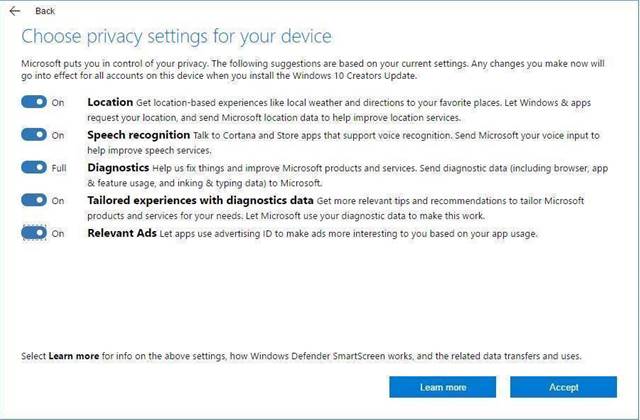Microsoft has opened up on the types of data Windows 10 collects from users, in an effort to allay concerns about the operating system's information gathering practices.

The company's Windows chief Terry Myerson said Microsoft hoped the transparency would allow customers to make "more informed choices" as it starts rolling out its new Creators update to the OS.
Microsoft made diagnostic data collection mandatory in Windows 10. In previous versions of the operating system telemetry had been voluntary; now users can only opt either for the 'basic' or 'full' telemetric settings.
It caused a significant backlash from consumers and regulatory bodies the world over concerned about the impact the data gathering had on individuals' privacy.
The company said it uses the diagnostic data to "get more relevant tips and recommendations to tailor Microsoft products and services for [users'] needs." Windows 10 has the default 'full' telemetry option as well as the pared back 'basic' setting users can choose to fall back to.
But until today Microsoft had not offered detail on what specific information it collects.
In two blog posts published today, Microsoft revealed it takes in common, device, connectivity, configuration, product and service usage, software setup and inventory, content consumption, browsing, search and query, inking, typing, speech utterance, licensing, and purchasing data in the 'full' telemetry option.
A detailed list of the type of data within each category can be found here. The more personal information collected spans product purchases made on the device, including the payment type; browsing history; voice calls and voicemail usage; and specific movies, music, and TV consumed.
The basic level gathers a "limited set of information that is critical for understanding the device and its configuration", Microsoft said.
It includes basic device information, quality-related information, app compatibility, Windows store data, and security information.
"Our commitment to you is that we only collect data at the basic level that is necessary to keep your Windows 10 device secure and up to date," Myerson said.
The company did not detail how frequently it transmits the data in either telemetry option.
However, Myerson said Microsoft had reduced the volume of data it collects at the basic level by half in response to user concerns. He did not detail any changes to the full level or what specific data Microsoft had stopped collecting.
Microsoft changed its data collection practices with Windows 10 in January following the privacy backlash. It ditched an 'enhanced' telemetry option and introduced a screen in the Creators update where users are asked to review their privacy settings.




.png&h=140&w=231&c=1&s=0)




_(26).jpg&w=100&c=1&s=0)

 iTnews Executive Retreat - Security Leaders Edition
iTnews Executive Retreat - Security Leaders Edition












_(1).jpg&h=140&w=231&c=1&s=0)



